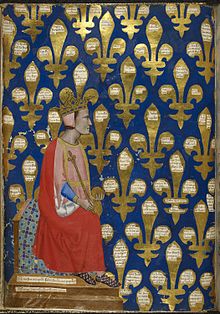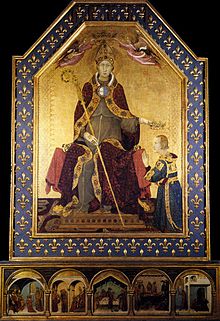Robert of Anjou

Robert of Anjou ( Italian Roberto d'Angiò ; * 1278 ; † January 20, 1343 ), also called "the wise" (Italian il Saggio ), was a king of Naples from 1309 to 1343.
Life
He was a son of King Charles II "the Lame" of Naples and Mary of Hungary. Robert is mentioned for the first time in 1288 when he and his brothers Ludwig and Raimund were taken hostage by the King of Aragon in exchange for his father.
When King James II of Aragon released him at the end of 1295, his father appointed him vicar . On February 24, 1297 he was made Duke of Calabria . This is explained by the fact that Robert's eldest brother, Karl Martell , was initially intended for the Hungarian throne and also died early, while the second oldest brother, Louis of Toulouse , who was later canonized , entered the Franciscan order early. Although Karl Robert of Hungary , the son of Karl Martell, was still a pretender with higher legitimacy, Robert was able to ascend the throne after the death of his father. He had the support of the Pope and that of his younger brothers, because Karl Robert was still a minor and Robert had already shown himself to be a defender of the Guelfish cause against the Ghibelline Aragon.
Robert of Anjou married Yolande of Aragon, the marriage itself was staged by Pope Boniface VIII . Robert had in the meantime lost Sicily to Frederick II of Sicily . In 1299 the war broke out again. Robert broke off the campaign after a few defeats. As the legitimate successor, Robert von Anjou was crowned King of Sicily by the Pope in Avignon ten years later, after the death of his father on May 5, 1309 .
In the following years Robert became the leader of the anti-Imperial Guelphs and took over the Signoria in several cities in northern Italy. It was precisely at this time that the political situation in Italy was about to fall apart, when the Roman-German King Henry VII stood with his army at the gates of Rome in the spring of 1312 and sought a restauratio imperii . The tensions between Robert and Heinrich built up, Neapolitan troops also took part in the battle against Heinrich in Rome. He, who had been emperor since June 29, 1312, sentenced Robert to death for crimes of majesty in the spring of 1313, but was no longer able to implement the sentence because of his early death (August 24, 1313). Numerous memoranda had been written on behalf of both the emperor and Roberts. The emperor insisted that Robert had to answer to him - and in fact Robert was a vassal of Henry at the same time, since Robert owned several imperial territories. Robert, on the other hand, rejected this and questioned the empire itself. But even after the emperor's death, this situation did not change: the Tuscan Guelphs were devastated in the battle of Montecatini in 1315 , brother and nephew died.
Pope John XXII. eventually helped Robert of Anjou regain his reputation in Italy. It was only when Ludwig the Bavarian moved to Italy in 1327 that Robert was again in distress, while at the same time he was wearing out his strength in an unsuccessful attempt to conquer Sicily.
Despite the failures in politics and the twelve failed campaigns, Robert von Anjou enjoyed a pretty good reputation. He owed his nickname of the sage to his exceptionally active involvement in the promotion of science and art. He promoted Francesco Petrarca , whom he crowned poet, and Giovanni Boccaccio, as well as artists such as Tino di Camaino , Simone Martini and Giotto di Bondone .
He left the financial system and the export of wheat, the most important commodity, largely to the Florentine trading and banking companies of Bardi, Acciaiuoli and Peruzzi, which he privileged .
Marriages and offspring
In his first marriage Robert was married to Yolande von Aragon († 1302), a daughter of King Peter III, from 1297 . von Aragon and Konstanze von Hohenstaufen . Your children were:
- Charles (* 1298 in Naples; † November 9, 1328 there), Duke of Calabria
- Ludwig (* 1301 in Catania ; † August 12, 1310 in Naples)
In 1304 Robert married Princess Sancha of Mallorca, daughter of King James II of Mallorca and the Esclarmonde of Foix in Perpignan . The marriage remained childless.
Robert had at least three illegitimate children:
- Maria d'Aquino († 1382): She was Boccaccio's Fiammetta , involved in the murder of Andreas of Hungary , she was therefore beheaded by Karl von Durazzo .
- Charles d'Artois (* around 1300; † 1346), Conte di Santa Agata de 'Goti: His son was the murderer of Andrew of Hungary and was therefore poisoned on behalf of Charles von Durazzo.
- Fiametta († before 1343): She fell in love with Andreas Thopia and married him against her father's will. Together with him she was executed in Naples on the orders of her father.
literature
- Romolo Caggese: Roberto d'Angiò ei suoi tempi. 2 volumes. R. Bemporad e Figlio, Florence 1921–1930.
- Émile G. Léonard: Les Angevins de Naples. Presses universitaires de France, Paris 1954.
- Lorenz Enderlein: The burial places of the Anjou house in southern Italy. Cult of the dead and monuments 1266–1343 (= Roman studies of the Bibliotheca Hertziana. Vol. 12). Werner, Worms 1997, ISBN 3-88462-128-9 (also: Berlin, Humboldt University, dissertation, 1993).
- Tanja Michalsky : Memoria and Representation. The tombs of the Anjou royal family in Italy (= publications of the Max Planck Institute for History. 157). Vandenhoeck and Ruprecht, Göttingen 2000, ISBN 3-525-35473-8 (also: Munich, University, dissertation, 1995).
- Tanja Michalsky (Ed.): Media of Power. Art at the time of the Anjous in Italy. Reimer, Berlin 2001, ISBN 3-496-01231-5 .
- Samantha Kelly: The New Solomon. Robert of Naples (1309-1343) and Fourteenth-Century Kingship (= The medieval Mediterranean. Peoples, Economies and Cultures, 400-1500. 48). Brill, Leiden et al. 2003, ISBN 90-04-12945-6 .
Web links
Individual evidence
- ↑ Revista bimestrale di Scienze, Lettere ed Arti . Ateneo Veneto, Venice 1908, p. 7 (Italian).
| predecessor | Office | successor |
|---|---|---|
| Charles II the Lame |
King of Naples 1309–1343 |
Johanna I. |
| Charles II the Lame |
Count of Provence 1309–1343 |
Johanna I. |
| Mathilde of Hainaut |
Prince of Achaia 1318–1322 |
John of Durazzo |
| personal data | |
|---|---|
| SURNAME | Robert of Anjou |
| ALTERNATIVE NAMES | Robert the Wise; Roberto il Saggio; Roberto d'Angiò |
| BRIEF DESCRIPTION | King of Naples |
| DATE OF BIRTH | 1278 |
| DATE OF DEATH | January 20, 1343 |
